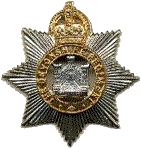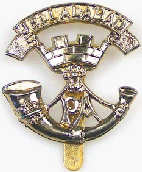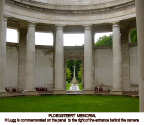
|
| HOME PAGE |
| MEMORIAL CROSS |
| HISTORY of the CROSS |
| ROLL of HONOUR |
| LINKS |
Private
Herbert Lugg Previously enlisted in the Previously enlisted in theDevonshire Regiment 203407 1st Battalion Somerset  Light Infantry Light Infantry(11th Brigade, 4th Division, 1st Army) 235141 Died 15.04.18 aged 38 Herbert William Lugg was born on 15th December 1878, the eldest son of Thomas Lugg, a general labourer who had been born at Dolton, and his wife Jane Coombe, also born at Dolton. In 1901 the family were living in Moor View, Winkleigh, and consisted of Herbert, aged 22 and a general worker, Blanche aged 11 and Gilbert aged 5. The eldest sister Beatrice Ella was 20 employed as a cook/domestic for an 82 year old Civil Engineer, his wife and two unmarried daughters, living in Torquay. Ten years later the 1911 census shows Herbert married to Bessie Passmore, who had been born in Wembworthy, with the family living in Lowertown. Prior to her marriage, Bessie had been working as a housemaid at Ward Mill, Winkleigh. Up to 1911 Bessie and Herbert had no children, but just before the war their son, Albert Lugg, was born on 22nd December 1912, registered on February 3rd 1913, and christened in Winkleigh church two days later on 5th. Before his enlistment Herbert was working as a road contractor’s labourer. Herbert’s brother, another Thomas Lugg, was originally employed as a grocer’s carter, living in Exeter in 1901. In 1909 he married Alice, formerly Hammett, and was living in the village. His daughter Ella Elizabeth was born on 1st march 1914, when his profession was reported as a road contractor, probably employing his brother Herbert. They had a daughter, Ella Elizabeth, born on 1st March 1914. The Chumleigh Deanery magazine reported that Thomas Lugg, then aged 30, had attempted to volunteer in 1914, but had been rejected. The Roll of Honour, however shows that he was later enlisted into the Rifle Brigade, and thankfully survived. Herbert’s other brother, Gilbert, also served. Though only 17 or just 18, he had volunteered at once for the 6th Battalion of the Devons Territorials and he also survived. We know from the Devonshire regimental records that Herbert Lugg enlisted in Winkleigh into the Devonshire Regiment, but we do not know when. The Chumleigh Deanery Magazine does not include his name among those seeking to join the Devons Territorials when war broke out, but since these lists were abandoned after the first early months they are hardly a reliable source of evidence. His medal record shows that he was not in France in 1915. The crucial evidence is Herbert Lugg’s first army number on his medal card, 230407, which proves that he had first enlisted into a Territorial battalion Men who had enlisted (or who had already enlisted pre-war) directly into a Territorial unit, and were therefore not subject to the Military Service Acts (conscription) of 1916 were given new army numbers on 1st March 1917, by an Army Council Instruction published on 23rd December 1916. Each corps of Infantry was allocated a block of numbers starting at 200001. The allocation for each infantry corps was then broken into smaller blocks for each battalion. Those men who had enlisted in a Territorial Army 4th Battalion, for example the 4th Battalion of the Devons (the senior Territorial Battalion in the Devonshire Regiment), were allocated numbers 200001 to 240000, those of the 5th Devons 240001 to 265000, and so on. From Herbert Lugg’s T.A. number 235141 we can therefore be sure that he had joined the 4th Battalion of the Territorials. The Devonshire Regiment expanded all three of the original Territorial Battalions, the 4th, 5th and 6th, quite soon into second line battalions for each. There seem to be two possibilities about Herbert’s period of service and at this stage, without further information forthcoming, we cannot be sure about what happened. Everything depends on the date in which he was first enlisted into the Devons. There were three phases in which men were enlisted into the army generally throughout the country: Phase 1: The voluntary phase, August 1914 to the opening of the Derby scheme in October 1915, and indeed during the period of the Derby Scheme itself which closed on 15th December 1915. The first two of these three periods could have applied to Herbert Lugg as an older and married man. The definitive history of the 1st Battalion, by Major Majendie, quotes the battalion war diary that while in ‘rest’ between 10th and 21st August 1916, a huge draft of 121 men arrived, among them 60 Hampshire cyclists and 30 from the West Somerset Yeomanry. This was followed almost at once by a second draft of 80 men from the Devons. The Battalion War Diary reported: ‘A draft of 80 arrived, a good many being Devons. Nearly all had been out before’. Private Herbert Lugg might have been among them, but it seems unlikely. Further drafts were received however, usually on the many occasions when the battalion was in a period of rest, so that we cannot be definite as to when he was posted. Very seldom was any mention made in the War Diary of the units of origin in the draft, and there is only the one reference to postings from the Devons: we assume of course that reinforcements for the most part arrived from the Somerset Light Infantry’s own 3rd Battalion. A close examination of the Battalion War Diary reveals the following drafts of other ranks between August 1916 and April 1918: Depending when Herbert Lugg was enlisted and trained, his arrival with the Somerset Light Infantry might have been on any of these occasions. Certainly he was very lucky if he had survived more than eight or nine months in the battalion, the average expected survival time of any infantry soldier. (Incidentally, 2nd/Lts. had an even shorter average span, usually no more than three months for the lucky ones.) With this in mind the large draft of September 3rd 1917 could have marked Herbert Lugg’s possible arrival, since it seems they were all ‘first timers’ in France. Another likely possibility was the draft of October 15th 1917, making up some of the losses after the Battalion’s experience of Passchendaele. We can pick up the story of the 1st Somerset on March 4th 1917, when the Battalion was transferred to the 4th army area, in preparation and training for the forthcoming Spring offensive, the attack at Arras and Vimy Ridge on April 9th 1917. The attack was planned on a wide front from Vimy Ridge in the North to south of the River Scarpe. The 4th Division were to form the Northern face of the salient to be driven into the German position, with the 11th Brigade in the front line on the left, tasked with attacking the German fourth line defences. The first three lines were captured and the SLI moved through to attack the fourth. The Germans were well entrenched and the wire was completely intact. However, gaps were found, the first trench taken, and the complete fourth line was captured. Meanwhile, on the left, Vimy Ridge was captured by the Canadians. The battalion lost 50 other ranks and 2 officers killed or wounded, casualties described as ‘light’. Further attempts to move forward, however, on 10th April, failed because there was no artillery support (communications with the rear area having completely broken down) and casualties were very heavy. A further attack on 11th was no more successful. The battalion remained in the line until 14th, suffering the abominable weather which had marked the whole attack since 9th and were withdrawn, completely exhausted. 10 officers had been killed or wounded and 127 men. The remainder moved into rest on April 21st for 7 days. The battle of Arras was resumed on April 23rd 1917, and on May 3rd, the battalion was ordered to attack the village of Roeux at 3.45 a.m. The attack failed. Roeux Wood was not sufficiently shelled, machine guns could not be located and the maps were incorrect. A further 8 officers and 132 men were killed or wounded, and the SLI remained in the line until May 14th, when another month of rest was granted. Back in the line, opposite Roeux, on June 11th, a period of quiet activity followed but with plenty of sniping, trench mortaring and patrolling to break the monotony. The trenches were again abominable, flooded and collapsing even in summer. Each Brigade was in the line for 16 days (8 in the front line, 8 in support) followed by 16 days divisional reserve, when of course incessant numbers of working parties had to come up every night for wiring and trench repairs. On September 4th 1917 the 4th Division went into training for the next major attack, taking their turn in the Passchendaele offensive, as the British High Command systematically rotated 55 Divisions (some 98% of all the British infantry divisions on the Western Front) through the continuing carnage. Passchendaele, known as the third battle of Ypres, lasted from 31st July to 16th November 1917 as British and Germans fought each other to utter exhaustion in a welter of mud and blood. The Germans by this time had learnt to dispense with lines of defensive trenches which could be destroyed by the artillery, and to rely instead on a defensive system based on scattered concrete pill-boxes which could both support each other while withstanding efforts to destroy them, and immediate counter-attacks in force to regain any ground lost. The British had to evolve entirely new tactics to deal with these changes, and this required very new and careful training. On September 18th the Battalion moved into Belgium, one mile south of Poperinghe, for intensive training, and on October 1st into the front line for the next attack. Heavy rain worsened the already atrocious conditions of the ground with the abominable mud that slowed down any advance, and the shell holes full of water. The attack of October 4th 1917 took place just south-east of Poelkapelle in the north-west area of the Ypres salient, the objective being a group of so-called ‘houses’ just south-west of the village. Assembly took place during the night for zero hour at dawn. During 3rd October, owing to the absence of any kind of jumping off trenches, tapes were laid across the mud to form the assembly line, and officers went out to take compass bearings of the ‘objectives’, though not a single tree or building was standing. The mud was so bad that duck-boards had to be laid, even to get the men into their forward positions. The tracks were of course continually shelled by the Germans, but the Battalion was in position by 11.00 pm, with the loss of only one man. The attack took place on a two platoon front, the rear platoons dealing with the pill-boxes that had been bypassed in the forward attack. Unfortunately the creeping barrage fell somewhat short and a number of men were killed by ‘friendly fire’. Moving on from the first objective, the attack was stalled for an hour to clean rifles and Lewis Guns choked with mud, before moving on to reach the final objective. The houses were taken and a line reached just west of Poelkapelle, after which counter-attacks were repulsed. Losses were dreadful: 1 officer killed and 8 wounded, 282 other ranks killed, wounded or missing. The Battalion War Diary report included: ‘A satisfactory feature of the day was the way in which the last draft of about 200 behaved. Though for the most part only 19 years of age and never having been under fire before, they showed the greatest keenness and determination, and behaved excellently.’ For many it was their first and last battle. On 7th October 1917 the remains of the Battalion went into Divisional Reserve, eventually in Poperinghe, where drafts were received. On 18th, the 4th Division was returned to the 3rd Army, to spend the winter in and out of the line in the Monchy area, Arras, where repairs of the entire trenches in the sector were organised on a Divisional basis by the Royal Engineers, battalions providing the labour force. As a result the winter trenches were well revetted and duck-boarded, with reasonable dug-outs, some even heated for the drying of gum-boots. Whale-oil was used to combat trench-foot and hot meals were provided in the forward lines. Health improved. The tour was 4 days in the front lines, 4 in support and 4 days in reserve, followed by 12 days in Divisional reserve either in Arras or in camp on the Arras-Cambrai road, during which time, of course, large working parties had to be found. In spite of much work, heavy rain and frost in December and January played havoc with the trenches, communication trenches filled with water and men had to move to and fro by night in the open. Plans were drawn up to counter the German attack in the spring, now seemingly inevitable, and as much training as possible carried out. We need to understand the circumstances and difficulties faced by the British army in 1918 at the time of the great German offensive, which explains to a large extent why the initial stages of the attack proved so successful, and how near the Germans were to achieving total victory. Only the fact that the speed of the advance outran their supplies, advancing as they were over the smashed battlefields of the Somme, coupled with the fact that a change of plan diverted a main thrust from the Channel ports, allowed the British army to prevent the capture of Amiens and with it the collapse of the entire British front. After the failure of the Passchendaele offensive in 1917, and the mutinies in the French army, the French had requested that the British line should be extended southwards. Up to 1917, the British front had extended from the Ypres salient in Belgium down as far as the Somme below Albert, a length of some hundred miles. In comparison, the French line extended some 300 miles, from the Somme down to the Swiss border. But now, in 1918, the situation of the war had entirely changed. The collapse of Russia and the October revolution that brought Lenin and the Bolsheviks to power was swiftly followed by the treaty of Brest-Litovsk that took Russia out of the war. This meant the release of hundreds of thousands of German troops for use on the Western Front, and indeed an unrivalled opportunity for Germany to win the war before a vast American army could arrive in France and save the allies from what seemed almost certain defeat. After the Somme battles of 1916, followed by Passchendaele and Cambrai in 1917, the lines of the Western Front had hardly changed more than a few miles each way in three years of war. Now, with the defeat of Russia and the transfer of German division after division to the Western Front, the ultimate objective of the allies became an impossible one, at least for the time being. Roles were reversed. Now it was the German army that could take the offensive, which a reduced and overstretched British army, with no elaborate defensive structures in place, would find immensely difficult to resist. The Germans were aware that the British defences were in no state to withstand a determined attack. Lines were sited to the allies’ disadvantage, wire was flimsy, machine-gun posts were inadequately sandbagged. There were few deep dug-outs, no deeply buried signal network. The old British and German lines on the Somme and Ypres, which could have provided defence in depth, had been allowed to collapse in disrepair, while gun emplacements were not properly concreted. The state of the trenches was for the most part indescribable. The old regular army had long gone – by late 1915 in fact - and Kitchener’s New Army had followed them. There remained now only the army of conscripts, waiting for the inevitable coming battle. Code-named ‘Michael’, with huge forces concentrated behind the immensely strong Hindenburg Line, the first attacks code-named ‘Michael’ were launched on March 21st 1918 from Armentieres in the north to the junction of the British and a joint Franco-British front at Barisis in the south, just above the river Oise. The second German offensive, known as Operation Georgette began on April 9th to the south of Ypres just to the east of Armentieres, aiming to drive the British back to the Channel ports. With his ‘Backs to the Wall’ order of the day on 11th April 1918, Haig ordered that every position must be held to the last man. The Battle of the Lys, as this campaign became known resulted in 109,000 German casualties, 76,000 British and 6,000 Portuguese. The immediate objective was to preserve Bethune, situated behind the main defensive line of the La Bassee Canal. La Bassee itself was in German hands. Between Bethune and the canal and in the area north of the canal, including the old 1915 battlefields of Festubert and Givenchy, a large number of Battalions of 3rd, 61st and 55th Division were concentrated, using reconstituted old French trenches and their strong support lines just north of Bethune. The 1st Battalion of the Somerset Light Infantry, part of 11th Brigade, were among them, with the line held by the 4th Division itself resting on the right on the north bank of the river Scarpe. This position was considerably exposed by the ‘Michael’ attack, and in spite of all the elaborate defences that had been built during the winter, Monchy had to be abandoned without a fight. ‘Georgette’, opening on April 9th 1918 was met by the 4th Division and the 56th Division on its left with great determination and courage, but by 29th March the Battalion had lost 3 officers and 80 other ranks. On April 9th the Battalion went into Brigade reserve to receive a draft of 3 officers and 162 men. On April 12th the 10th Brigade went into the line again, the Battalion holding positions along the southern bank of the La Bassee Canal. The La Bassee Canal itself was part of the British front line defence system for a distance of some 7000 yards (about 4 miles) before the line turned sharply north. At this corner there was a nasty salient jutting into the British defensive system, which the 4th Division was obviously very concerned to eliminate. The plan to do this involved the capture of the village of Riez du Vinage. The operation was bound to the difficult and costly, involving an assault across the canal under shell and machine-gun fire. On April 12th 1918 the 1st Battalion Somerset Light Infantry had moved up to the line, first by bus and then by marching, from a point south of Arras to the village of Bellerive, about a mile and a half behind the British front line along the canal. That night, leaving one company in Bellerive, together with battalion headquarters, ‘C’ and ‘B’ companies took over an outpost line between ‘Douce Crème Farm’ and a footbridge across the canal. An outpost line indicates that there was no continuous line of trench, either because not enough troops were available, or because trenches had not been dug. In fact, the battalion was able to make some use of old French trenches, not yet fallen into total disrepair as well as shell-holes used for makeshift cover. The ‘Light’ Company (‘D’) were in reserve in a farm on a small hill, Mount Bernenchon. ‘A’ also remained in reserve at Bellerive. An already reduced battalion, the Somersets were covering a length of about 2 miles, a fact that reveals that after huge casualties since the German offensive, British defences were indeed very thinly spread. In fact, this part of the line was being held by the confused remains of various Divisions and formations, including men from the 51st Division and the 3rd Division, dismounted cavalry from King Edward’s Horse and men of the Tank Corps who had been dismounted and who had brought with them their Lewis Guns. The battalion remained in this situation all the following day, April 13th, sending out daylight patrols across the canal, to gather more information on the strength and disposition of the Germans in the village of Riez du Vinage. These patrols resulted in at least one subaltern wounded: the Germans were well aware of what was going on, and were shelling our positions, setting fire to the farm on Mount Bernenchon some 500 yards behind the line. They could not, however, prevent the right-hand company of the Somersets further extending their line east from the footbridge to a road fork some way beyond. The German advance was at a temporary standstill, waiting for the field guns to catch up, together with the supply wagons. The 4th Division was ordered to stop the enemy advancing any further. For an image of the Operations map of The Lys for the 13th April 1918 click HERE. The following day, 14th April, battalion headquarters moved up nearer the line. At a conference at Brigade headquarters, company commanders received orders for a local attack across the canal, the 1st Somersets being selected to assault the village itself. At the same time the 1st Hampshires were to move up behind the Somersets, before swinging left to form a new line from Carvin, a village just behind the British line as it turned North, (held by 61st Division) across to Riez du Vinage, thus eliminating the awkward salient, and greatly strengthening the British line of defence. The canal remained the last natural defensive position before the Germans could break through and reach Bethune, Lilliers and the coal-fields of Bruay, and it was imperative that it should be held. Major Majendie’s account of the Battalion mentions two important aspects of the situation: first, that the countryside had not yet been devastated, and second that military operations were made much more difficult by the crowds of refugees passing along the canal, fleeing from the advancing Germans. Some indeed were attempting to regain their possessions in no-man’s land itself. Many of these were unfortunately killed or wounded in the attack across the canal, ordered for 6.30 pm on the evening of 14th. ‘A’ company remained in reserve, with the remaining three companies moving across the canal. A few advanced posts had been established on the northern bank the previous night, and battalion headquarters moved across the canal at 6.00pm. Because of the shortage of bridges the main body of the battalion had to first cross the canal in daylight and take up their assault positions in the dark, ready for the attack. In order not to arouse suspicion the troops began to cross in ones and twos from 6.00 pm onwards, covered by an artillery barrage in front of Riez. At zero hour plus ten minutes the barrage was intended to move forward, to bombard the village itself. The operation order for the attack contained the following order: ‘The village will be taken at all costs, and every man in the Battalion will be used to obtain this object if necessary.’ The attack did not go quite according to plan. By 6.00 pm the whole battalion had crossed the canal, but the forming up process was understandably confused. Having crossed the canal the battalion had then to deploy half-right in order to be parallel with the village, which was in any case semi-circular in shape. In the event the forming up line was some distance short of that planned, so that the attacking troops were not able to get close enough to the creeping barrage to be given the cover they needed. In addition, some shells fell short and caused casualties to our own men. German machine guns pinned down many though ‘A’ company commander gallantly led two of his platoons forward, so that by a series of rushes the remains of the company finally reached the village. A few Germans surrendered, others continued to fight, many were killed. On the right of the village ‘A’ Company (Light Company) came under heavy machine gun fire from the Bois de Pacaut, and were checked until these guns were silenced by artillery fire and ‘A’ Company’s own machine gun barrage. A German counter-attack from the Northern end of the Bois de Pacaut was successfully dealt with, capturing many prisoners and six machine guns. By 7.15 pm the village was in British hands, the troops began to dig in, and shortly before dawn two platoons of the Rifle Brigade came up as reinforcements. At dawn on 15th, a new German counter-attack from the North was dispersed by the Battalion’s machine guns, inflicting very heavy casualties on the enemy. Orders were then received that the 10th Brigade would attack the neighbouring Bois de Pacaut at 5.40pm on 15th and the SLI would co-operate in the attack. Unfortunately, there was no time to give this difficult and complicated operation the detailed operational planning it deserved, and orders were hurriedly cobbled together by Brigade, in an attempt to organise a ‘pincer movement’ by battalions of two different regiments. ‘A’ Company, SLI, facing the edge of the wood on the north, was selected for this task, in conjunction with a battalion of The Duke of Wellington’s Light Infantry, 10th Brigade. The Dukes duly crossed the canal and attacked the wood from the west, coming under heavy artillery fire and suffering serious casualties. It was too late to stop the supporting attack by the two platoons of ‘A’ Company, SLI. Gallantly, they entered the wood unsupported either by artillery or the Dukes and met serious opposition, suffering 50% of their number killed or wounded, before inevitably falling back. It was in this action that Private Herbert Lugg (A ‘Light’ Company) was killed. Either his body was left and was never seen again, or he was blown up by shell fire. The following day the Germans retired from the area, and thus ended the otherwise successful operations carried out by the Battalion on April 14th, 15th and 16th. The results of their endeavours were certainly impressive. The village of Riez du Vinage had been captured and a bridgehead secured across the canal. A battery of British field-guns and a second battery of 4.5 howitzers had been recaptured. Sixteen German light machine guns, a heavy mortar and four heavy machine guns were taken, plus a re-captured Vickers gun. The equivalent of a German battalion had been killed, captured or wounded. 135 prisoners were sent to the rear. But our losses had also been severe in this very difficult action. 5 officers (4 wounded) were casualties, together with 210 other ranks, killed, wounded or missing.
28 April 2012 |
|---|
| [Top] | Back to MEMORIAL CROSS |

Click on an image for a larger picture |
 Herbert Lugg’s name is recorded on the Ploegsteert Memorial which contains the names of 11,389 men of the United Kingdom and South African forces who died in this sector and have no known grave. Those commemorated here did not die in major offensives such as Ypres to the north or Loos to the south: most were killed in day-to-day trench warfare or in small scale operations. The Memorial is 12.5 kms. south of Ypres, on the road from Ypres to Messines, Ploegstreet and on to Armentieres, and is situated 3 kms. beyond the town of Mesen. Unusually, the sounding of the Last Post takes place at the memorial on the first Friday of every month at 7.00pm.
Herbert Lugg’s name is recorded on the Ploegsteert Memorial which contains the names of 11,389 men of the United Kingdom and South African forces who died in this sector and have no known grave. Those commemorated here did not die in major offensives such as Ypres to the north or Loos to the south: most were killed in day-to-day trench warfare or in small scale operations. The Memorial is 12.5 kms. south of Ypres, on the road from Ypres to Messines, Ploegstreet and on to Armentieres, and is situated 3 kms. beyond the town of Mesen. Unusually, the sounding of the Last Post takes place at the memorial on the first Friday of every month at 7.00pm.


